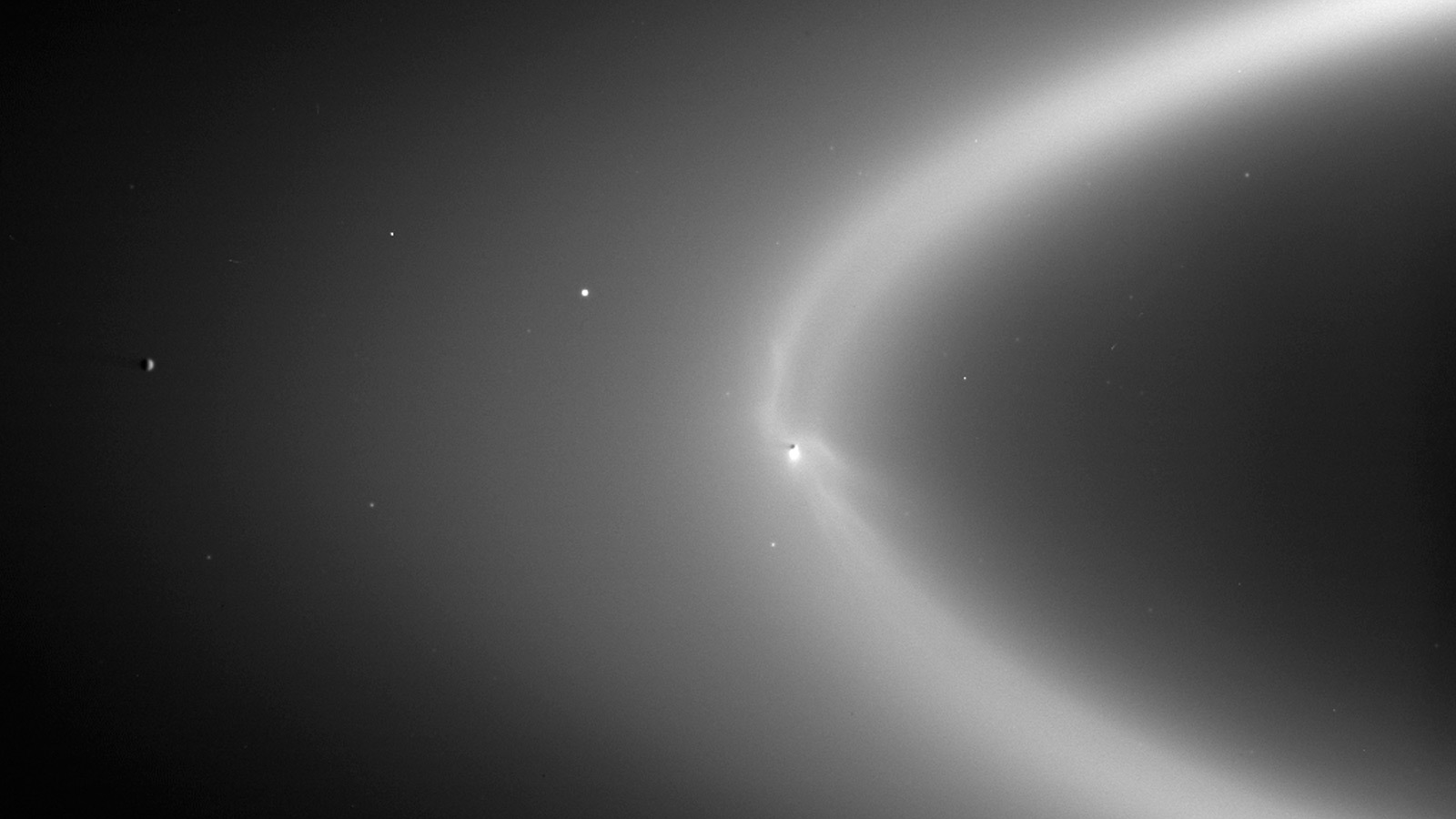 PIA08321 reveals Saturn's broad, diffused E ring, which is composed primarily of tiny particles that were easily detectable by the CDA.
PIA08321 reveals Saturn's broad, diffused E ring, which is composed primarily of tiny particles that were easily detectable by the CDA.
See
Volume 1-Mission Overview, Science Objectives and Results for full science report. The technical report is in other volumes archived at the Jet Propulsion Lab.
Mission Science Highlights and Science Objectives Assessment provides a brief overview of the mission
Download the CDA SIS
About CDA
The Cosmic Dust Analyzer (CDA) consisted of two instruments that detect incoming particles: the High Rate Detector (HRD) and the Dust Analyzer (DA). These co-aligned instruments were mounted on a turntable that allowed them to articulate. The HRD was designed, built and tested at the University of Chicago. The DA was developed and built as a joint project by the Institute of Planetary Research at the German Aerospace Center (Deutsches Zentrum für Luft- und Raumfahrt; DLR) in Berlin Adlershof and the Max Planck Institute for Nuclear Physics (MPI-K). It contained components that were developed at the University of Kent in Canterbury, UK.
Scientific objectives for the CDA include the following:
- Extend studies of interplanetary dust out to the orbit of Saturn
- Map the size distribution and analyzing the chemical composition of ring material in and near the known rings
- Study the dynamical processes (erosional and electromagnetic) responsible for E ring structure, study the interactions between the E ring and Saturn's magnetosphere, search for electromagnetic resonances
- Determine the role that dust plays as a source and sink of magnetospheric charged particles
- Study the chemical composition of icy satellites from studies of ejecta particles
- Study the effect of Titan on the Saturn dust complex
CDA Detectors:
- High-Rate Detector (HRD): Particle count and mass for particles with a known speed
- Dust Analyzer (DA): Electric charge, impact direction, impact speed, mass and chemical composition of the particles it detects
CDA Instrument Characteristics *
| General Characteristics |
|
|
| Measurable Particle Mass Range (kg) |
Lower |
Upper |
| Impact @5 km/s |
10-16 |
10-10 |
| Impact @40 km/s |
5 x 10-19 |
10-13 |
| Detectable Impact Speed (km/s) |
>1 |
| High-Rate Detector (HRD) |
|
|
| Measurable Impact Rate (s-1)
| <104 |
| Measurable Particle Mass Range (kg) @15 km/s |
Lower |
Upper |
| Differential and Integral Flux |
~8 x 10-16 |
8 x 10-11 |
| Integral Flux |
>8 x 10-11 |
| Detectors |
Sensor #1 |
Sensor #2 |
| Area (cm2) |
50 |
10 |
| Thickness (μm) |
28 |
6 |
| Dust Analyzer (DA) |
|
|
|
|
|
| Digitized Measurement Channels |
QPa |
QTb |
QCc |
QId |
MPe |
| Measure Quantity |
Induced Primary Charge |
Negative Impact Charge |
Negative Impact Charge |
Positive Impact Charge |
Cation TOF-MS |
| Data Acquisition Frequency (MHz) |
6 |
3 |
6 |
6 |
100 |
| Sampling Frequency (MHz) |
| Before Impact |
6 |
0.375 |
0.375 |
0.375 |
0 |
| After Impact |
6 |
3 |
6 |
6 |
100/10 |
| Sampling Time After Impact (µs) |
83 |
83 |
35 |
83 |
6.4 @ 100Mhz + 38 @ 10 Mhz |
| Signal Amplitude Resolution (bits) |
8 |
8 |
8 |
8 |
8 |
| Measureable Charge Range (C) |
10-15–6 x 10-13 |
2 x 10-14–10-8 |
1 x 10-14–10-8
| (not applicable) |
(not applicable) |
|
| Signal Rise Time (μs) |
|
0.5–150 |
0.2–10 |
0.2–90 |
0.01 |
| Particle Parameter |
Speed: 2–40 km/s |
Speed: 2–40 km/s |
Mass |
Mass |
Chemical Composition |
|
Trajectory in One Plane |
Mass: 10-15–10-9g |
Speed |
Speed |
m/Δm = 20–50 |
|
Primary Particle Charge |
|
|
|
|
aQP - entrance grids (EG)
bQT - impact ionization detector (IID)
cQC - chemical analyzer target (CAT)
dQI - ion grid
eMP - multiplier dynode
* includes values taken from Tables VIII and IX of Srama et al. (2004) in Space Science Reviews
The HRD detected up to 10,000 particles per second, while the DA detected 1 particle per second. The HRD was capable of detecting particles at a higher rate and therefore returned only particle count and mass for particles with a known speed. Assuming a particle velocity of 15 km/s, the HRD detected particles within a range of 8x10-16 to x10-11 kg for differential and cumulative flux measurements and >8x10-11 kg for cumulative flux measurements. The DA used four grids spanning its aperture to determine the electric charge, impact direction, impact speed, mass and chemical composition of the particles it detected. The DA accomplished these goals through the use of three subsystems: the charger detector, the impact ionization detector and the chemical analyser. Particles impacting at 10 km/s, and larger than 5.9x10-17 kg (corresponding to a spherical grain with a radius of 0.25 µm and density of 930 kg/m3) should have been detected by the DA.
The engineering details of the CDA instrument and the science objectives it was built to address are described in further detail in the
Space Science Reviews paper by
Srama et al. (2004). Additionally,
Kempf (2008) includes an example of analysis and dead-time correction.
CDA Data
Data Search Tools
- The Event Calendar is an interactive event finding-tool that can be used to search for data associated with particular events.
- The Master Schedule is a time-ordered listing of observations by all instruments. This can be used to find data based on particular events.
Browse Raw Data Products
 PDS: The Planetary Atmospheres Node
PDS: The Planetary Atmospheres Node
